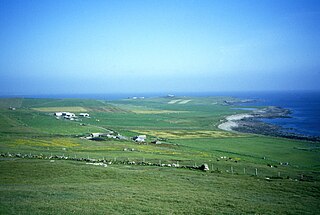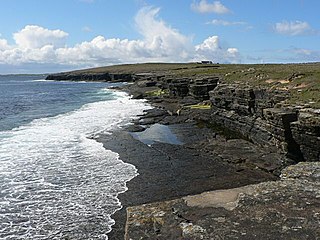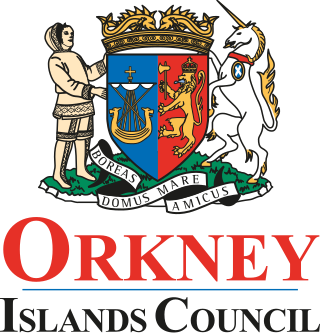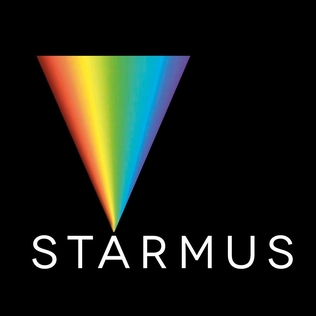
Orkney, also known as the Orkney Islands, is an archipelago in the Northern Isles of Scotland, situated off the north coast of the island of Great Britain. Orkney is 10 miles (16 km) north of the coast of Caithness and has about 70 islands, of which 20 are inhabited. The largest island, the Mainland, has an area of 523 square kilometres (202 sq mi), making it the sixth-largest Scottish island and the tenth-largest island in the British Isles. Orkney's largest settlement, and also its administrative centre, is Kirkwall.

Kirkwall is the largest town in Orkney, an archipelago to the north of mainland Scotland.

Saint Magnus Erlendsson, Earl of Orkney, sometimes known as Magnus the Martyr, was Earl of Orkney from 1106 to about 1117.

The Mainland, also known as Hrossey and Pomona, is the main island of Orkney, Scotland. Both of Orkney's burghs, Kirkwall and Stromness, lie on the island, which is also the heart of Orkney's ferry and air connections.

Sanday is one of the inhabited islands of Orkney that lies off the north coast of mainland Scotland. With an area of 50.43 km2 (19.5 sq mi), it is the third largest of the Orkney Islands. The main centres of population are Lady Village and Kettletoft. Sanday can be reached by Orkney Ferries or by plane from Kirkwall on the Orkney Mainland. On Sanday, an on-demand public minibus service allows connecting to the ferry.

Westray is one of the Orkney Islands in Scotland, with a usual resident population of just under 600 people. Its main village is Pierowall, with a heritage centre, the 15th-century Lady Kirk church and pedestrian ferry service to nearby Papa Westray island. Westray has a number of archeological sites dating from 3500 BC, and remains of several Norse-Viking settlements. The spectacular sea cliffs around Noup Head are home to thousands of seabirds.

Papa Westray, also known as Papay, is one of the Orkney Islands in Scotland, United Kingdom. The fertile soil has long been a draw to the island.

The Northern Isles are a pair of archipelagos off the north coast of mainland Scotland, comprising Orkney and Shetland. They are part of Scotland, as are the Hebrides. The climate is cool and temperate and much influenced by the surrounding seas. There are a total of 36 inhabited islands. The landscapes of the fertile agricultural islands of Orkney contrast with the more rugged Shetland islands to the north, where the economy is more dependent on fishing and on the oil wealth of the surrounding seas. Both island groups have a developing renewable energy industry. Both have a Pictish and Norse history. Both were part of the Kingdom of Norway until they were absorbed into the Kingdom of Scotland in the 15th century. They remained part of it until the 1707 formation of the Kingdom of Great Britain and the 1801 formation of the United Kingdom. They both played a significant naval role during the world wars of the 20th century.

St Magnus Cathedral dominates the skyline of Kirkwall, the main town of Orkney, a group of islands off the north coast of mainland Scotland. It is the oldest cathedral in Scotland, and the most northerly cathedral in the United Kingdom, a fine example of Romanesque architecture built for the bishops of Orkney when the islands were ruled by the Norse Earls of Orkney. It is owned not by the church, but by the burgh of Kirkwall as a result of an act of King James III of Scotland following Orkney's annexation by the Scottish Crown in 1468. It has its own dungeon.

The University of the Highlands and Islands (UHI) is an integrated, tertiary institution encompassing both further and higher education. It is composed of 12 colleges and research institutions spread around the Highlands and Islands, Moray and Perthshire regions of Scotland. UHI offers further education, undergraduate, postgraduate and research programmes which can be studied at a range of locations across the area and online. It has 31,000 students, including 19,779 further education students and 11,210 higher education students.
Robert Rendall (1898–1967) was a Scottish poet, and amateur naturalist who spent most of his life in Kirkwall, Orkney.
Ernest Walker Marwick was a Scottish Orcadian writer noted for his writings on Orkney folklore and history.

Brian Edward Cox is an English physicist and former musician who is a professor of particle physics in the School of Physics and Astronomy at the University of Manchester and The Royal Society Professor for Public Engagement in Science. He is best known to the public as the presenter of science programmes, especially BBC Radio 4’s The Infinite Monkey Cage and the Wonders of... series and for popular science books, such as Why Does E=mc²? and The Quantum Universe.

Damsay is an islet in the Orkney archipelago in Scotland. It is approximately 18 hectares (0.07 sq mi) in extent and rises to only 11 metres (36 ft) above sea level. It is situated in the Bay of Firth north of the Orkney Mainland near Finstown. Nearby is the smaller islet of Holm of Grimbister.

The Orkney Islands Council, is the local authority for Orkney, Scotland. It was established in 1975 by the Local Government (Scotland) Act 1973 and was largely unaffected by the Scottish local government changes of the mid-1990s.

Balfour Hospital is a rural general hospital in Kirkwall, Orkney. It is managed by NHS Orkney.

Prehistoric Orkney refers only to the prehistory of the Orkney archipelago of Scotland that begins with human occupation. Although some records referring to Orkney survive that were written during the Roman invasions of Scotland, “prehistory” in northern Scotland is defined as lasting until the start of Scotland's Early Historic Period.

The Starmus International Festival is an international gathering focused on celebrating astronomy, space exploration, music, art, and sciences such as biology and chemistry. It was founded by Garik Israelian, an astronomer at the Institute for Astrophysics in Tenerife, Canary Islands, Spain and Brian May of the rock band Queen.
The Edinburgh Medal is a scientific medal given at the Edinburgh International Science Festival since 1989. The Edinburgh Medal is an award given each year to men and women recognized for their contributions to science and technology and whose professional achievements have made a significant contribution to the understanding and well-being of humanity. It was instituted by the City of Edinburgh Council in 1988 and has been presented at the Edinburgh International Science Festival since 1989. Each year the recipient attends an awards ceremony and delivers an address at the Festival.
Mary Anne Baikie (1861–1950) was a Scottish suffragist who established the Orcadian Women's Suffrage Society (OWSS) and grew the membership and public interest in the debate, in the Orkney Isles, during the campaigns for Votes for Women.